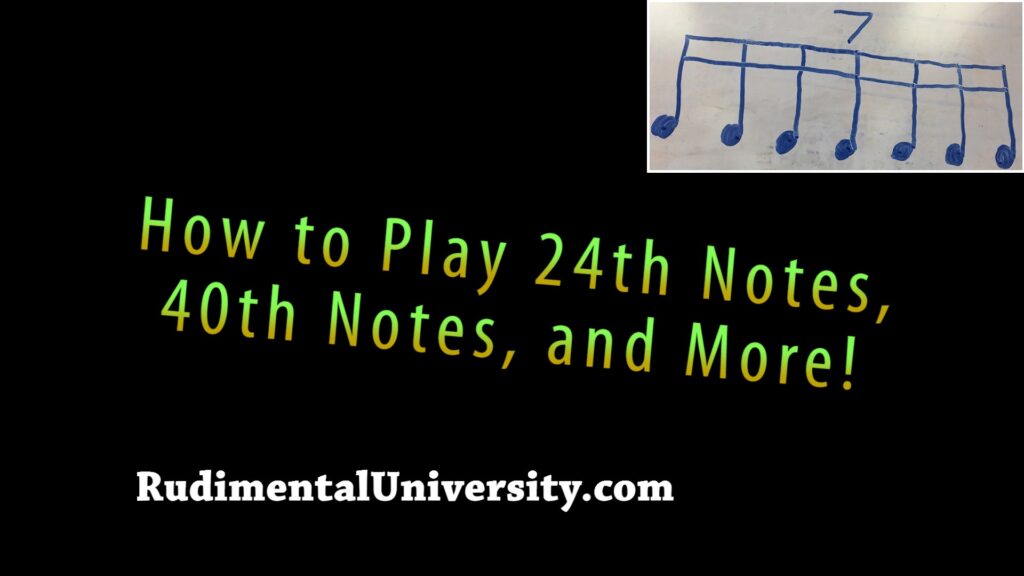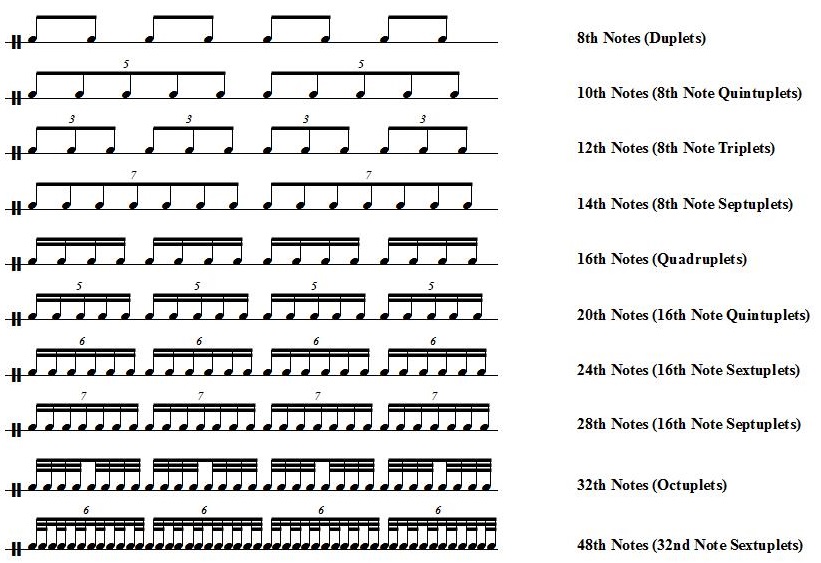
Do you know how to count 24th notes, 40th notes, or 48th notes? James walks you through some terminology that may just revolutionize your understanding of rhythm. The following is a modified transcript of the video above:
***************************
Hello, everybody. This is James Christian with RudimentalUniversity.com.
Today I want to talk about rhythm terminology. Most musicians don’t frequently deal with this particular concept I’m going to discuss, but drummers and percussionists deal with it all the time.
We’re used to whole notes, half notes, quarter, notes, 8th notes, 16th notes, etc. And we also have tuplet patterns, such as half note triplets, quarter note triplets, 8th note triplets, 16th note triplets, and so forth. In this article, I’m going to talk about the way we discuss tuplet patterns and how we can make it a little bit easier.
This method is especially easier when you’re writing on the Internet and typing. It also makes your terminology more consistent, regardless of the type of note you’re discussing. When you’re writing, this method will save space, and it’s just a nice shorthand for your terminology.
So here it is…
Common Time: The Basis of All Note Values
If you think about it, 8th notes are called “8th notes” because there are eight notes in a measure of 4/4 time (common time). A whole note is a WHOLE note, because it comprises the WHOLE measure. It’s only “whole” in common time. If you have a whole note in, for example, 6/4 time, it’s still called “a whole note.” But it’s “whole” referring to common time. So common time is the basis for all the note names that we use in rhythms.
Within common time, we are used to having eight 8th notes in a measure. We also have sixteen 16th notes in a measure. That’s why they are called “16th notes.”
What about 8th note triplets? We call them “8th note triplets,” but if you look at a full measure of triplets, there are 12 notes. So you could call these “12th notes.” Additionally, you could called quarter note triplets “6th notes.” We regularly refer to this fraction terminology when we refer to quarter notes (“4th notes”), half notes (“2nd notes”), and whole notes (“1st notes”).
All of these terms could be used for longer length notes (8th notes, quarter notes, half notes, etc.), but we generally have common terminology for these, and I think the current system works pretty well. However, when you get to shorter length notes in large number groupings (sextuplets, septuplets, nontuplets, etc.), I think this understanding of note lengths becomes very beneficial.
A New Perspective on Tuplet Rhythms
You can have quintuplets (5 notes), sextuplets (6 notes), septuplets (7 notes), octuplets (8 notes), nontuplets (9 notes), dectuplets (10 notes), undectuplets (11 notes), duodectuplets (12 notes), etc. After about 10 notes, most people have a hard time even knowing what the correct terminology is.
However, if you know the number of notes in common time (4/4), it’s very easy to refer to a specific note length. Hence, quintuplets can also be called “20th notes.” Sextuplets could also be called “24th notes.” Septuplets could also be called “28th notes.” “32nd notes” are already common terminology when discussing octuplets. Nontuplets could be called “36th notes.” Dectuplets are “40th notes.” Undectuplets are “44th notes.” Duodectuplets are “48th notes.” At normal tempos, you don’t usually see much higher than this, but the list theoretically goes on forever.
Here is a chart showing some of the more common possibilities:

This terminology becomes especially helpful when you’re playing double stroke rolls. (That’s why this terminology may not seem as useful to non-percussionists.) If you’re playing sextuplets (24th notes), and you want to put double strokes on every note, you automatically have 48th notes. Of course, you can refer to playing a “12-let” or something like that, but it’s just a nice shorthand to say, “I’m playing a 48th note roll.”
In my opinion, the key note values to memorize are:
- Triplets
- 8th note triplets = 12th notes
- 16th note triplets = 24th notes
- 32nd note triplets = 48th notes
- Quintuplets
- 16th note quintuplets = 20th notes
- 32nd note quintuplets = 40th notes
Triplet-based rolls at all three speeds are incredibly common. Quintuplet-based singles and doubles aren’t as common, but they are still common enough to warrant a shorthand way of referencing them.
Advantages of this Terminology
Being able to quickly refer to “40th note rolls” or “48th note rolls” makes for easier conversation. It’s also faster to type, and it makes for consistent terminology when speaking of different note lengths.
It reads much easier to read this list: 16th notes, 20th notes, 32nd notes, 40th notes, and 48th notes.
It’s much more cumbersome to read this list: 16th notes, 16th note quintuplets, 32nd notes, 32nd note quintuplets, 32nd note sextuplets.
Additionally, there are some books on the market that actually refer to rhythms this way. And I occasionally see this terminology mentioned in Internet discussions.
Conclusion
So if you’re encountering these terms: 1) I just wanted to help readers know what they are, in case the terminology was unfamiliar. And 2) I want to give new options in discussing our rhythmic vocabulary. If someone says, “Hey, let’s hear a 48th note roll,” you know exactly what they’re talking about. That’s much simpler than saying, “Hey, let’s take 16th note sextuplets, and double those, and then you got a 12-let kind of thing—yeah, play that.”
Well, I don’t know that this article is going to create a huge revolution in the terminology percussionists use, but hopefully it’ll get the general idea out there. If you want to sound like you know you’re talking about, you can use this terminology. And if other people use it, then now YOU know. You’re “in the know.”
Well, that’s it for today. Have fun drumming, and have fun playing through all these crazy tuplet patterns! See you next time!
What do you think? Is this terminology helpful? Do you already use it? Do you have any other applications for it? Please leave your thoughts in the comments section below.
